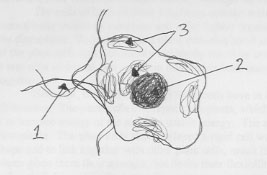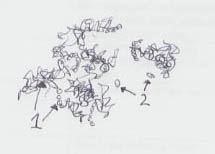
Eukaryotic Cell Structure Laboratory Report
Jonathan Paul Loomis
September 8, 1998, Revised as of September 24, 1998
TA: Heather Emmitte
Introduction
Overview
Our first laboratory project involved a basic study of the makeup of the Eukaryotic Cell. This cell type is typical of most multi-celled members of the Kingdoms Anamalia and Plantea, and is important to the study of biology because of its unique role as the most basic unit of more elaborate organisms. The Eukaryotic Cell, although made up of smaller units known as organelles remains the smallest independent, fully functioning unit in these two Kingdoms.
Purpose
The purpose of this laboratory exercise was to identify similar and different animal and plant cell structures and to further our understanding of their functions. The laboratory was further intended to teach us to differentiate between these two types of cells and also the Eukaryotic and Prokaryotic cells.
Hypothesis
My prediction was that the cells of the Plantea Kingdom would appear boxy, in hexagonal patterns, with thick cell walls that would lend themselves to the rigid strength needed by most plants for survival. I further predicted that the cells of the Anamalia Kingdom would appear less rigid and more bulbous in shape what lends themselves to the greater variety of movement needed for the members of this kingdom.
I chose this hypothesis because is reflects what I learned in high school and my guesses as to what different types of cell structures would most benefit the cells of these two different kingdoms.
Procedure
The following is a list of materials used in this lab:
The procedures used in this lab are identical to those laid out on pages nine and ten of the lab manual, with the following exceptions: no dye was used in step 3 of page nine, and the toothpick was not stirred in the NaCl as in step 1 of page 10, but rather the NaCl as applied to the slide after the cheek cells were placed there. We also added to the experiment the observation of prokaryotic cells in the form of Stentors in pond water.
Results
View of the leaf of and Anacharis plant magnified 400 times

In this view I observed that no nucleus was visible. I saw a possible plasma membrane seen as thin dark line (2). There were possible tonoplasts seen as a thin white line surrounding each cell (3). I also saw very clear cloroplasts (4). These were seen moving in-groups as a bunch, in lines, or alone. They were often viewed moving along the cell wall, but it was not uncommon to view them moving across the center of the cell. This they did mostly in-groups, a process known as cytoplamic streaming.
View of Human cheek cells magnified 400 times:

In this view I observed that the cells were overlapping one another (1). There was a dark nucleus that was clearly visible in the center of the cell (2). Lighter colored organelles without clear shapes were seen around the nucleus (3). There were not seen to move. There was no clear cell wall visible, or any other part of the cell wall.
View of pond water and prokaryotic cells magnified 400 times:

There was a great deal of organic material (1) visible in this slide which might have interfered with the observation of the organisms. I did see a possible prokaryotic organism that was visible only for very short periods of time as it was seen to move in extremely fast, short spurts across the slide (2). I do not believe that this was a Stentor.
Plant Cell vs. Animal Cell Comparison Chart
Based on samples of Anacharis cells and Human cheek cells
|
|
Plant Cells |
Animal Cells |
|
Nucleus |
None visible |
Clear, dark nucleus visible and unmoving in the center of the cell |
|
Organelles |
None visible |
Unclear, light colored organelles were visible. |
|
Cloroplasts |
Many clearly defined cloroplasts were seen to be moving about the cell individually and in groups. There seemed to be some attraction between them and the cell wall. |
None visible |
|
Cell wall |
A very clear cell wall was visible which included various divisions within itself. |
No cell wall |
|
Plasma Membrane |
Possible plasma membrane seen inside the cell wall. |
A very thin plasma membrane was seen surrounding the cell. |
|
Shape |
Boxy, often hexagonal, with nearly strait edges. Did not overlap other cells. |
Rounded, with no regular shape. Often overlapped other cells. |
Eukaryotic vs. Prokaryotic Cell Comparison Chart
Based on samples of Anacharis cells, Human cheek cells, and prokaryotic organisms
|
|
Eukaryotic Cells |
Prokaryotic Cells |
|
Cell Wall |
The plant cells that fall under the category of the Eukaryites have rigid cell walls, while the animal cells have none. |
None of the Prokaryotes have cell walls. |
|
Organelles |
All Eukaryotic cells have organelles to carry out their functions. |
The Prokaryotic cells also all have organelles. |
|
Sillia |
The Eukaryotes do not have sillia. |
Many of the Prokaryotes have sillia to facilitate movement through their liquid environment. |
|
Nucleus |
This is the defining factor between the Eukaryotes and the Prokaryotes. The prefix "eu" in old Greek means "true" and this accurately describes the Eukaryotic cells as having a nucleus. |
Unlike the Eukaryotes, the Prokaryotes lack a true nucleus. The only thing they have is a region of nucleic material. |
Discussion
The cells I observed during this laboratory exercise presented a clear contrast between those cells of the Kingdom Anamalia and those of the Kingdom Plantea. While the cells of both of these kingdoms are classified as Eukaryotic and therefore have certain characteristics in common, their functions dictate that they will also be very different.
The cells of both of these kingdoms contain certain organelles. In the animal cells these were clearly visible as a nucleus and other lighter organelles, and in the plant cells these included the cloroplasts. Both animal and plant cells displayed some sort of cell membrane. In the case of the plant cells this was mostly hidden by the more prominent cell wall, and in the animal cells it was only observed as a very thin line, but in both cases it was there and it did hold the cell together.
However, for all these things these cells have in common, they also have their differences. The plant cells displayed cloroplasts, which contain the plant's chlorophyll allowing it to turn the energy of the sun into usable energy. The animal cells naturally were lacking these cloroplasts. The plant cells also displayed a rigid cell wall, which allowed them to maintain their shape and to link together with other plant cells, much like the bricks of a wall. The cell was of plants gives them their strength, but limits their flexibility. This is why the skin of animals is soft and pliable, while the bark of trees is not. Animal cells displayed a clear nucleus which the plant cells did not. This is perhaps misleading, as we do know that plant cells have a nucleus.
The animal and plant cells differed because of the specific nature of their function. The plant cells require a rigid cell wall to help support them and the weight of the tree. The animal cells, on the other hand, require the more flexible cell membrane so that they can move about in their environment freely.
The Stentor, being a Prokaryote, and therefore different from both the plant and animal cells had sillia around its flexible cell membrane in order to facilitate movement.
In general I believe my observations were compatible with those of the rest of the class. It is possible that a few of the other members of the class were able to see the various aspects of the plant cell wall more clearly or the organelles of the animal cell more clearly, but this would not have significantly changed my conclusions.
My prediction that the cells of the Plantea Kingdom would appear boxy, in hexagonal patterns, with thick cell was correct, other than the fact that not all of the cells presented a perfect hexagonal shape. I further predicted that the cells of the Anamalia Kingdom would appear less rigid and more bulbous in shape what lends themselves to the greater variety of movement needed for the members of this kingdom. This prediction was correct.
It was unfortunate that I was unable to view the animal cell with a higher-powered microscope that would have allowed me to inspect the various organelles in more detail. It is altogether possible that this would have given me valuable insight into their various purposes. It was also unfortunate that I was unable to view the cell walls of the plant cells in more detail, as I believe that I could have separated the cell membrane and cell wall with some certainty. I also think that with a more powerful microscope I could have viewed the plant cell's nucleus or other organelles. The other clear shortcoming of this particular experiment was that it was performed using only one example from each of the kingdoms. To gain a more clear understanding of the structure of the various Eukaryotic cells I feel it would be necessary to view specimens from various plants and animals.